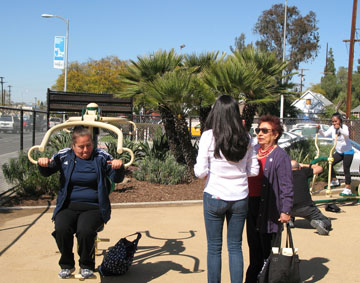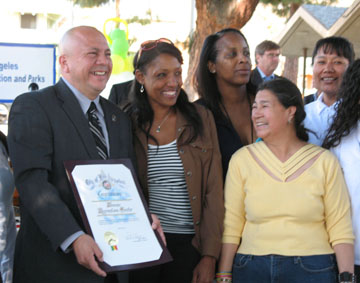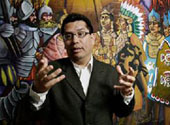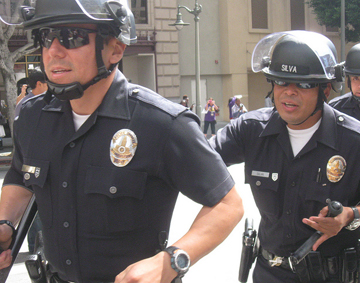 Listen to the audio story from Annenberg Radio News:
Listen to the audio story from Annenberg Radio News:
The White House Office of National Drug Control Policy’s new Drug Control Strategy for 2012 recommends roughly equal spending on treatment and punishment.
It allocated $10.1 billion on prevention and treatment; $9.4 billion on law enforcement and incarceration; $3.6 billion on drug interdiction; and $2.1 billion on international programs.
Meghan Ralston of Drug Policy Alliance, a national organization advocating marijuana legalization and de-criminalization of other lesser drugs and amounts, was underwhelmed. “It’s essentially been the exact same allocation of funds, the exact same approach, since the days of Nixon. So it’s really just the same old, same old.”
Ralston thinks Gil Kerlikowske, the President’s drug czar and head of the ONDCP, and the Administration are trying to do the right thing, but they’re going about it from the wrong direction.
“The policies that are in place at the federal level, and the rhetoric that’s happening at a federal level, is really inconsistent and out of touch with what a lot of the American people want and what a lot of American people need and really the direction the rest of the country is headed.”
With polls showing overwhelming support for medical marijuana, Ralston said, there’s a big disconnect between federal policy and popular will.
Kerlikowske has been touring the country to tout the new strategy. He held a news conference at Los Angeles’ First African Methodist Episcopal Church, in the West Adams district, to highlight a portion of the community-based approaches the administration thinks may be more effective at the local level. The Drug Free Communities Support Program offers small grants to community groups that address youth substance abuse.
Standing in the church’s sunny garden, Kerlikowske said local faith organizations reach more people regularly than he could possibly reach himself. “These are the folks that touch people every single day.”
He also said the new strategy will take into account the rising scourge of prescription drug abuse. “It was just a few years ago that no one talked about the problem of prescription drugs. Now prescription drugs take more lives in this country than heroin and cocaine overdoses combined.”
Whether the new strategy will be any more effective in combatting this and other forms of drug abuse than prior attempts remains to be seen.
Additional information can be found here.









 Hoover Recreation Center is a small little pocket park situated at the busy intersection of 25th and Hoover. It’s in the bustling working-class neighborhood of South Adams, which nestles up against the University of Southern California.
Hoover Recreation Center is a small little pocket park situated at the busy intersection of 25th and Hoover. It’s in the bustling working-class neighborhood of South Adams, which nestles up against the University of Southern California.
 Lopez is 55 years old and lives in Mexico. Her older sister is dying of cancer here in the United States. Her request for a humanitarian visa to cross the border was denied at the US Consulate in Tijuana. Local immigrant rights activist Juan Jose Gutierrez held a press conference today at the Federal Building in downtown LA to bring attention to Lopez’s plight. When asked why her visa request was turned down, he said, “They never tell you what’s insufficient. They simply tell you that whatever evidence in this case she presented, in the judgement of the adjudicator—the consular officer—was insufficient”.
Lopez is 55 years old and lives in Mexico. Her older sister is dying of cancer here in the United States. Her request for a humanitarian visa to cross the border was denied at the US Consulate in Tijuana. Local immigrant rights activist Juan Jose Gutierrez held a press conference today at the Federal Building in downtown LA to bring attention to Lopez’s plight. When asked why her visa request was turned down, he said, “They never tell you what’s insufficient. They simply tell you that whatever evidence in this case she presented, in the judgement of the adjudicator—the consular officer—was insufficient”. The new plans call for a mixed-use development with retail space on the ground floor and student housing above. The housing is especially important, because USC students have moved into housing that would have been rented by local families. The proposed housing units in the new development should return 900 units to the community, according to the Master Plan for University Village. However, this may not bring the expected benefits to the neighborhood. Paulina Gonzalez, Executive Director of Strategic Actions for a Just Economy (SAJE), a South Los Angeles community housing and economic development group, said,
The new plans call for a mixed-use development with retail space on the ground floor and student housing above. The housing is especially important, because USC students have moved into housing that would have been rented by local families. The proposed housing units in the new development should return 900 units to the community, according to the Master Plan for University Village. However, this may not bring the expected benefits to the neighborhood. Paulina Gonzalez, Executive Director of Strategic Actions for a Just Economy (SAJE), a South Los Angeles community housing and economic development group, said,  Ten anti-Wall Street protesters were arrested downtown Thursday afternoon after entering a Bank of America. They were a small part of Re-fund California, a coalition that marched to protest bank policies. They were joined by demonstrators from Occupy LA, who’ve been camping outside City Hall since this weekend.
Ten anti-Wall Street protesters were arrested downtown Thursday afternoon after entering a Bank of America. They were a small part of Re-fund California, a coalition that marched to protest bank policies. They were joined by demonstrators from Occupy LA, who’ve been camping outside City Hall since this weekend.





